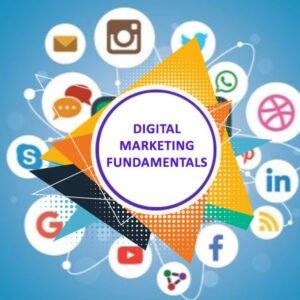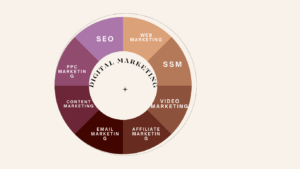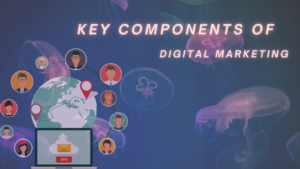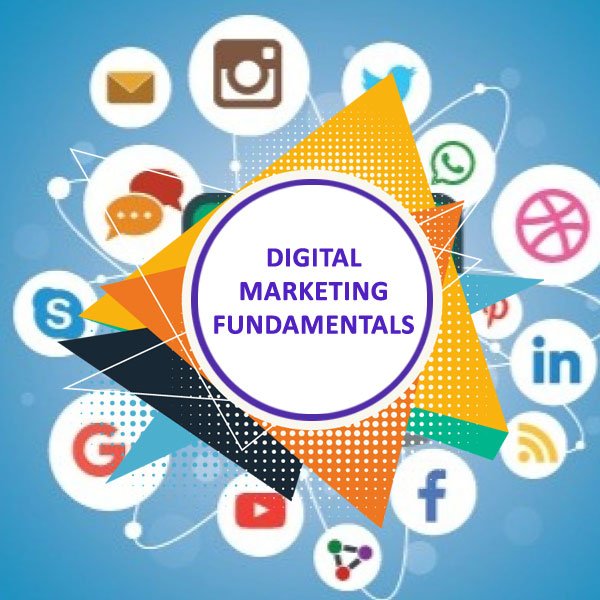
In today’s digital world, businesses need a strong online presence to be competitive. Understanding digital marketing basics helps you build brand awareness, connect with your audience, and increase sales online. This knowledge is important for entrepreneurs, small business owners, and anyone new to marketing.
This guide introduces digital marketing fundamentals and covers key strategies like SEO, content marketing, social media, and social media ads. Whether you’re just starting or looking to improve your skills, this guide will help you navigate the digital marketing landscape effectively.
Understanding Digital Marketing Fundamentals
What is Digital Marketing?

Digital marketing focuses on using online channels and tools to promote products and services. It focuses on reaching people through the internet, social media, search engines, and email, rather than traditional methods like print ads, billboards, and TV commercials. Digital marketing helps businesses engage with their audience effectively. Digital marketing is important because more people use the internet every day. It offers businesses a great way to connect with customers, boost sales, and achieve growth.
How Digital Marketing Fundamentals Help Businesses Grow
Reach More People – Digital marketing helps businesses find customers online. They can connect with people in their city or even in other countries.
Save Money – Digital marketing is cheaper than TV ads or billboards. Small businesses can use social media, emails, and websites without spending too much.
Find the Right Customers – Businesses can choose who sees their ads. They can pick people based on age, location, or interests. This helps them reach the right audience.
See What Works – Businesses can check how many people visit their website or click on their ads. This helps them improve and get better results.
Talk to Customers – Businesses can use social media, blogs, and emails to chat with customers. This helps build trust and keep people interested.
Sell More Products – Good digital marketing brings in more customers. More customers mean more sales and business growth.
Key Components of Digital Marketing

To create a strong online presence, businesses should know the key parts of digital marketing. Each part helps attract, engage, and convert customers.
1. Search Engine Optimization (SEO)
SEO helps a website show up higher on Google and other search sites. When a website is easy to find, more people visit it. This is good for businesses, blogs, and online stores. SEO has three main parts:
On-Page SEO: This means using the right words (keywords) so people can find your website. It also means making your content clear and helpful. Adding links to other pages on your website helps visitors find more information.
Off-Page SEO: This means getting other websites to link to your website. When trusted websites link to you, Google thinks your website is important. This website will boost your rank level.
Technical SEO: This is about making sure your website works well. Your website should load fast and look good on phones, tablets, and computers. If your website is slow or hard to use, people may leave, and Google may not rank it high.
2. Content Marketing
Content marketing is about making useful and interesting content to attract and keep an audience. This content can come in different forms, such as:
Blog posts – Articles that provide helpful information, tips, or news.
Videos – Engaging clips that explain ideas, tell stories, or entertain.
Infographics – Visuals that show information in a simple and easy-to-understand way.
Case studies – Real-life examples that show how a product or service helped someone.
When businesses create high-quality content, they build trust and become experts in their field. Good content also encourages people to take action, like buying a product, signing up for a service, or following a brand.
3. Social Media Marketing (SMM)
Social media platforms like Facebook, Instagram, and Twitter help businesses connect with people. A good social media strategy includes:
Creating shareable content: Posting interesting pictures, videos, and stories that people enjoy and want to share. This helps spread your brand to more people.
Running paid campaigns: Using ads to reach a larger audience. Businesses can target specific groups based on age, interests, and location to get the best results.
Engaging with followers: Replying to comments, answering messages, and joining conversations to build trust and loyalty with customers.
Each of these steps is important for a strong digital marketing strategy, helping businesses grow and reach more customers online.
4. Pay-Per-Click Advertising (PPC)
PPC (Pay-Per-Click) advertising is a way for businesses to show ads on search engines and social media. The business pays only when someone clicks on the ad.. This makes it a cost-effective way to get more visitors to a website quickly.
Where Can You Run PPC Ads?
Some popular platforms for PPC ads include:
Google Ads – Shows ads at the top of Google search results.
Facebook & Instagram Ads – Displays ads in people’s social media feeds.
LinkedIn Ads – Great for reaching professionals and business customers.
YouTube Ads – Plays ads before or during YouTube videos.
5. Email Marketing
Email marketing helps businesses build customer relationships. Key strategies include:
– Personalizing email campaigns
– Sending newsletters and promotional emails
– Automating onboarding and follow-up emails
Delivering valuable content increases engagement and conversions.
6. Affiliate Marketing
Affiliate marketing involves partnering with influencers or other businesses to promote products for a commission. Benefits include:
– Expanding brand reach
– Cost-effective marketing
– Gaining credibility through partnerships
Mastering these digital marketing fundamentals will help businesses build a strong online presence, engage with their audience, and drive growth effectively.
Why Digital Marketing Fundamentals Are Important
Digital marketing fundamentals are important because they help businesses grow in a smart and cost-effective way. Unlike traditional marketing, digital marketing allows businesses to reach more people while spending less money. It also helps target the right audience based on their interests, making advertising more effective.
One of the biggest advantages is that businesses can track their performance in real time, see what works, and make improvements quickly. This makes digital marketing measurable and easy to adjust for better results. Additionally, it helps increase brand visibility and customer engagement, building trust and loyalty over time. By mastering digital marketing fundamentals, businesses can attract more customers, improve sales, and achieve long-term success.
Steps to Start with Digital Marketing Fundamentals
-
Set Clear Goals
The first step in digital marketing fundamentals is to decide what you want to achieve, such as increasing sales, getting more visitors, or making people aware of your brand. Clear goals help you focus and track your success.
-
Know Your Audience
A key part of digital marketing fundamentals is understanding your audience. Learn who your customers are, what they like, and where they spend time online. This helps you create content that attracts them.
-
Choose the Right Platforms
Pick the best places to promote your business, such as social media, search engines, blogs, or email, based on where your audience is active.
-
Create a Content Plan
A strong content strategy includes making useful and interesting content, like posts, videos, or blogs, to keep people engaged with your business.
-
Check and Improve Your Results
Use tools to track your success. If something is not working, change your strategy to get better results. The more you learn and adjust, the more successful your digital marketing fundamentals strategy will be.
Common Challenges in Digital Marketing Fundamentals & How to Overcome Them

1. Understanding the Basics
Problem: Many beginners find it hard to understand digital marketing fundamentals like SEO, content marketing, and social media. Solution: Start with free online courses. Websites like Google Digital Garage and HubSpot Academy offer easy lessons to help you learn digital marketing fundamentals.
2. Choosing the Right Digital Marketing Channel
Problem: There are many choices like social media, email marketing, SEO, and paid ads. It is difficult to pick the best one. Solution: Find out where your target customers spend time online. Start with one platform and check the results to improve your digital marketing fundamentals.
3. Creating Interesting Content
Problem: People lose interest if the content is boring or not helpful. Solution: Make high-quality, useful, and visually attractive content. Use videos, images, and stories to keep people interested.
4. Keeping Up with Trends
Problem: Digital marketing changes quickly, and it is hard to stay updated. Solution: Read marketing blogs, watch webinars, and join online groups to learn about new trends.
5. Getting More Website Visitors and Customers
Problem: Many businesses struggle to bring people to their websites and turn them into customers. Solution: Use SEO, social media, and paid ads to bring traffic. Offer free resources like eBooks or webinars to get leads.
6. Measuring Success
Problem: Without tracking, it is hard to know if a marketing strategy is working. Solution: Use tools like Google Analytics and Facebook Insights to check performance and make improvements.
7. Limited Budget
Problem: Small businesses often have little money for digital marketing. Solution: Focus on free methods like SEO, social media, and content marketing before spending on ads.
8. Competing with Big Brands
Problem: Competing with large companies can be difficult. Solution: Find what makes your business special and focus on a specific group of customers. Good customer service can also help.
By solving these problems, businesses can improve their digital marketing fundamentals and get better results.
Conclusion
Understanding digital marketing fundamentals is essential for any business to grow in today’s online world. Important strategies like SEO, content marketing, social media, and analytics help businesses connect with the right audience and increase visibility. By learning and applying these strategies step by step, businesses can build strong online marketing plans.
The digital world is always changing, so it is important to stay updated, improve skills, and adapt to new trends. Businesses that embrace digital marketing fundamentals, experiment with new ideas, and refine their strategies will have a better chance of success. Keep learning, stay flexible, and use digital marketing to achieve long-term growth.

Leave a Reply